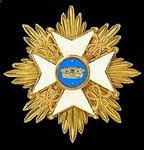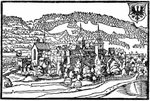On the 18th of January 1757 Louis XV accepted the offer of the Prince de Bouillon to raise a regiment in his principality and in the cantons neighbouring the Ardennes, to serve France as a foreign regiment and to remain within his house. The ordonnance for its creation was dated 1st February and specified a corps of 2 battalions of 680 men each.
Its colonel from 1st February 1757 to 21st October 1791 was Jacques-Léopold-Charles-Godefroy de La Tour d'Auvergne, Prince de Bouillon.
Ordonnance flags carried 1757-1791; the Colonel's flag was changed in 1772 to a more elaborate design with shield and coat of arms.
The regiment was ready to march the same year and was on the Rhine for the two campaigns of 1757 and 1758. Its usual quarters were at Dusseldorf. On the 1st of August 1759 the regiment fought valiantly at Minden [Kronoskaf says the regiment garrisoned Minden itself rather than fighting in the battle] where Captain the Marquis de Foudras was wounded. In 1760 its brigade, which also included the Liege regiments of Horion and Vierzet, was the second of the division of the Comte de Stainville. The first brigade was that of Auvergne. On the 10th of August Bouillon Regiment took part in the taking of Ziegenheim and on the 13th supported the valiant efforts of the regiment of Auvergne at the combat of Radern. The corps of generals Bulow and Fersen were there put to the most complete rout. After this affair the Stainville division approached the Rhine and passed under the orders of the Marquis de Castries in the camp of Meurs. Bouillon was made part of the reserve of this army and was posted between the camp and Rheinberg. On the 16th October there took place the battle of Clostercamps where the regiment did its duty well alongside the regiment of La Couronne. On the 30th August 1761 it fought again with the same corps at Roxel; it helped chase the enemy from that village and to push them "the sword in the kidneys" even under the cannon of Munster. In 1762 Bouillon served in the reserve of the Prince de Condé. Its grenadiers and chasseurs took part in the expedition to Osnabruck, which was the last of the war.
Bouillon, reduced to one battalion by 21st December, was put into garrison at Rocroi and Philippeville, from where it moved on to Montmédy in May 1763.
Text from Susane Volume 7; my translation.
And this is the uniform in the Seven Years War:
P.S. I did plan to do French Regiment Mailly from Rossbach next; flags and uniform are drawn but the text is vastly longer and more complicated than Bouillon so it will have to wait a while...




















Thank you for doing this one David, it’s a regiment on my want list!
ReplyDeleteThis flag may be one of my favorites. Nice work!
ReplyDeleteThat's great, Peter. :-) I'm tempted to do Horion and Vierzet too (which were brigaded with Bouillon), once I draw the column of Liege to use on the flags. Something about those flags and those of Bouillon really appeals to me...
ReplyDeleteAll the best,
David.
Mine too, Jonathan! Thanks. :-)
ReplyDeleteAll the best,
David.
That is one lovely flag. It’s worth doing the regiment just because of the flag.
ReplyDeleteWonderful work as usual, David. Thank you.
That is a beautiful flag (the first one) and you've done a great job on both of them. At first glance I thought it was American somehow due to the blue corners and red strips. Maybe I should bet my eyes tested again;)
ReplyDelete"Extrabio47 said...
ReplyDeleteThat is one lovely flag. It’s worth doing the regiment just because of the flag.
Wonderful work as usual, David. Thank you."
Thank you! Yes, I really like these flags too. :-) White with black facings also makes a somewhat unusual uniform for the unit.
All the best,
David.
Thanks, Steve. I hadn't thought they had an American look about them but, now you mention it, I really see what you mean! :-)
ReplyDeleteAll the best,
David.
Ooo! I've not seen that flag before?
ReplyDeleteIt's a good one, isn't it, Ray? Steve J said it made him think "American" and I can see what he means! Thanks for commenting.
ReplyDeleteAll the best,
David.